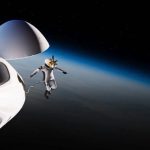NASA is committed to landing American astronauts, including the first woman and the next man, on the Moon by 2024. Through the agency’s Artemis lunar exploration program, we will use innovative new technologies and systems to explore more of the Moon than ever before. We will collaborate with our commercial and international partners to establish sustainable missions by 2028. And then we will use what we learn on and around the Moon to take the next giant leap – sending astronauts to Mars.
- Learn more about Artemis progress
Why Go to the Moon?
With the Artemis program we will:
- Demonstrate new technologies, capabilities, and business approaches needed for future exploration including Mars
- Establish American leadership and a strategic presence on the Moon while expanding our U.S. global economic impact
- Broaden our commercial and international partnerships
- Inspire a new generation and encourage careers in STEM
How Do We Get There?
NASA’s powerful new rocket, the Space Launch System (SLS), will send astronauts aboard the Orion spacecraft nearly a quarter million miles from Earth to lunar orbit. Astronauts will dock Orion at the Gateway and transfer to a human landing system for expeditions to the surface of the Moon. They will return to the orbital outpost to board Orion again before returning safely to Earth.
When Will We Get There?
Ahead of the human return, we will send a suite of science instruments and technology demonstrations to the lunar surface through commercial Moon deliveries beginning in 2021.
The agency will fly two missions around the Moon to test its deep space exploration systems. NASA is working toward launching Artemis I, an uncrewed flight to test the SLS and Orion spacecraft together, followed by the Artemis II mission, the first SLS and Orion test flight with crew. NASA will land astronauts on the Moon by 2024 on the Artemis III mission and about once a year thereafter.
What Will We Do There?
While Mars remains our horizon goal, we have set our sights first on exploring the entire surface of the Moon with human and robotic explorers. We will send astronauts to new locations, starting with the lunar South Pole. At the Moon, we will:
- Find and use water and other critical resources needed for long-term exploration
- Investigate the Moon’s mysteries and learn more about our home planet and the universe
- Learn how to live and operate on the surface of another celestial body where astronauts are just three days from home
- Prove the technologies we need before sending astronauts on missions to Mars, which can take up to three years roundtrip
Here is a video by NASA which explains the NASA Artemis Program in detail:
You can read more at: https://en.wikipedia.org/wiki/Artemis_program































[…] March, NASA revealed the NASA Artemis program science structure, which includes: an internal NASA Science Team an external Geology Team an […]
[…] the Artemis Program, The Artemis II mission will build on Artemis I, an uncrewed test mission that sent NASA’s Orion […]
[…] first crewed flight in the Artemis Moon-to-Mars era is scheduled to lift off no earlier than the end of 2024. Rather than touch down […]